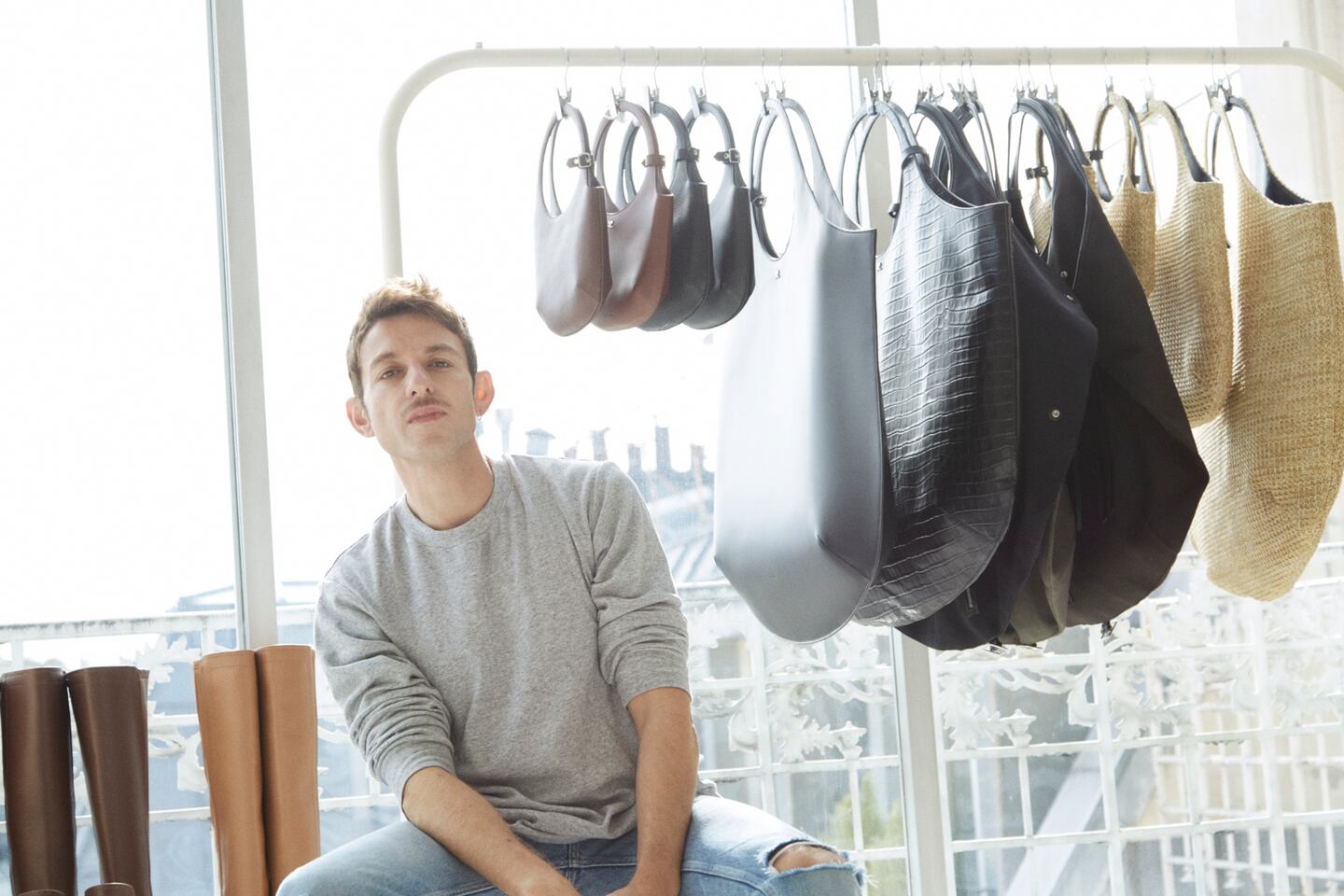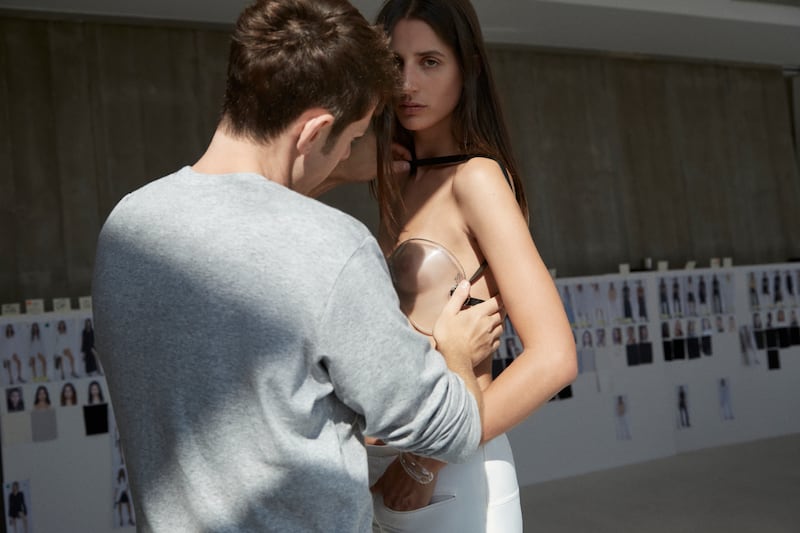
The Business of Fashion
Agenda-setting intelligence, analysis and advice for the global fashion community.

Agenda-setting intelligence, analysis and advice for the global fashion community.

PARIS – A monochrome atmosphere, its white intensified by the reflection of mirrors: We are not in heaven, but rather the fifth-floor design studio of creative director Nicolas di Felice at Courrèges.
Here, there is no disorder — only lines and rigour, white and mirrors, leather, coated cotton, and patch pockets. A century after the birth of founder André Courrèges, history feels brand new.
“Courrèges, it’s an attitude, a way of being, of moving, of dancing. I see grown-up girls walking, discovering new worlds,” said the 40-year-old designer, who took the helm of the brand at 40 rue François Premier three years ago.
Since the designer’s arrival, the brand (which operates separately from Gucci’s parent company Kering as part of the Pinault family’s Artemis fund) has more than doubled sales each year. A couturier who operates with sartorial precision while drawing inspiration from techno music, dance performances and nightclubs, the Belgian native first bonded with François Pinault père over a love of contemporary art.
ADVERTISEMENT
“I like the radical side of the void; I need it to make things exist,” Di Felice said.
Still, the designer has worked to renew the ties between space-age Courrèges and the Earth today. Appointed during the pandemic, Di Felice launched his tenure with an indelibly pointed campaign: “Courage,” read t-shirts and social media posts in the brand’s iconic font.
At his show during Paris Fashion Week on Wednesday, Di Felice is set to propose the brand’s latest wardrobe for gravity-defying Amazons. Traditional fibres like silk or double-crepe are blended with innovative silver materials, 3D-printed bras and blown-glass details.
Di Felice’s career has included stints at Balenciaga (where after being hired as a junior stylist, he stayed for 10 years), Dior with Raf Simons and Nicolas Ghesquière’s Louis Vuitton. Still, professional maturity has not diluted his work’s emotional charge. “This collection is perhaps the most personal,” he said of Spring 2024′s line-up of around 40 looks, in which Courrèges’ linear silhouettes are infused with a unique brand of romanticism.
Laurence Benaïm speaks to the designer for BoF.
LB: “We need to invent modern clothing, clothing that we enter into like a box,” André Courrèges once said. How can we reconcile this vision tied to the 1960s with contemporary issues?
NDF: The worst thing would be to try to copy, to parody, to try to resurrect what no longer exists. Nothing ages a brand more than imitating itself. The blowing dessert wind, which we hear in the soundtrack we composed with my friend Erwan Sène, is a sensation: It represents the idea that we must remain open to the spirit of the times.
LB: What keeps you moving forward?
ADVERTISEMENT
NDF: It’s the job itself: cutting, working on a model. The workshop is on the ground-floor, next to the boutique. The stylists are on the first floor, administration, merchandising and e-commerce on the sixth floor. We are in constant exchange, and this internal communication as well as the location itself is very inspiring. Everything is open, everything breathes. We do not remain stuck in a caricatured vision that would freeze the DNA of the brand.
We recently renovated the flagship store—adding mirrors everywhere including to create a sort of infinite fitting room. I love mirrors: they open spaces, deconstruct them.

LB: How do you grapple with the futuristic — or now maybe retro-futuristic — identity of Courrèges? His vision of the future was inspired by the race to the Moon, and yours?
NDF: I think Courrèges was very concerned by what was changing around him. It was the 60s, there was the euphoria of consumption, of having the best of all worlds. I like the idea that this house is linked to a form of utopia, of a project.
His strength is to have known, after ten years at Balenciaga, to adapt the rigor of lines to a new vision of the body in movement. White pants, jackets, dresses, miniskirts were like mobiles spinning in space.
My vision is radically linked to living together, to tolerance, to togetherness here on Earth rather than the Space Age: Accepting differences, whether linked to nationality, physical appearance, or sexuality.
LB: When you talk about “André,” what does he mean to you today?
NDF: We’ve all seen the same handful of images from his work so many times, whether we know his story or not. But André Courrèges remains a pioneer: a house that was created by two people who loved each other. I watched all his interviews repeatedly. Even if I immediately responded to the simplicity of his lines, the serial side of his work, his legacy is not limited to a few images.
ADVERTISEMENT
LB: How are you orchestrating the rebirth of the brand?
NDF: At the very beginning, we were still reissuing iconic pieces. Everything was done in a structured manner, step by step. So that the house could allow me to express myself, we had to reorganise, to redefine an identity.
From now on, there are no more reissues in the collections. For three years, we have more than doubled sales each year. We have expanded the distribution in France and internationally, notably opening a store in Seoul, and another in New York in 2022. We will continue to grow in Paris and Asia, with an expansion planned in China. In the meantime, we are launching three new fragrances this winter: Hyper Oud, Hyper Musc, Hyper Cuir.
LB: What about the materials used, the structured and slim Courrèges style?
NDF: In this season’s show, there will be almost no more vinyl. The one we use now is in fact a polyurethane “coating” mainly of plant origin which gives shine: the base is cotton.
The cut of the garments has evolved gradually, too. But the Courreges style is always present in the details which naturally punctuate a look: like applied pockets, which are found throughout the collection, topstitching, ellipses and rounded geometry.
The silhouette has evolved, while still being recognisable. We even go as far as oversize, so long as it still feels contained: I am thinking of a jacket which is a variation of the Scuba Biker from the archive.
Everything is clear and at the same time becomes more fluid. Embroidered tone on tone, the logos are increasingly discreet.
I don’t copy anything. My job is to reinterpret.
LB: What was it like to meet the brand’s owner, François Pinault, for the first time?
NDF: I will never forget his eye, the eye of a great collector, self-taught. He’s a builder, curious about everything. His first question was about my favourite artists. I said, I think Tracey Emin, Jenny Holzer.
He is betting on youth. He can change destinies — I’m the example of that, personified.
LB: It seems like music is very important to you. Why is that?
I come from a world where fashion did not exist. In the Belgian countryside, we didn’t have Vogue. My father is an engineer, my mother has a travel agency.
For me, everything came through music. I had an older sister who listened to rock, and covered her room with metal posters.
Music built me, it’s part of me. A piece of music corresponds to a piece of your life. It is the only art that can touch all the senses: in concerts everyone vibrates on the same waves.
As a teenager, I understood that you could shape your style through music and clothing. Carnival was normally every year. But I loved to dress myself up and dress up other people often. I did music theory, clarinet, piano. I was also a Scout: my parents tried to exhaust me.
I remained a go-getter.
LB: And where do you want to go?
On Earth—in nature, with people I love, plants and flowers. Nature gives us the measure of time, of waiting, of joy. In 2008, as a junior stylist at Balenciaga, I bought a plant at the end of a supermarket checkout, it became a magnificent tree. Recently, I took almost an entire day to clean it leaf by leaf.
LB: What concerts are you looking forward to?
There’s (La) Horde’s next performance. Then Blonde Redhead, from whom I tattooed their favourite song title on both my legs: “Futurism vs Passéism”. I love when they sing, “The most important time is the first time, The most important time is the second time. And after that, the third time. And we start again.”
Note: This interview translated from the original French has been edited and condensed.
From where aspirational customers are spending to Kering’s challenges and Richemont’s fashion revival, BoF’s editor-in-chief shares key takeaways from conversations with industry insiders in London, Milan and Paris.
BoF editor-at-large Tim Blanks and Imran Amed, BoF founder and editor-in-chief, look back at the key moments of fashion month, from Seán McGirr’s debut at Alexander McQueen to Chemena Kamali’s first collection for Chloé.
Anthony Vaccarello staged a surprise show to launch a collection of gorgeously languid men’s tailoring, writes Tim Blanks.
BoF’s editors pick the best shows of the Autumn/Winter 2024 season.